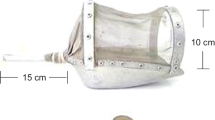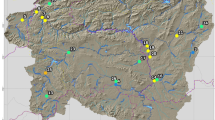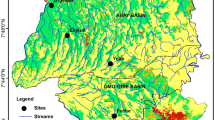Abstract
In order to standardise biological assessment of surface waters in Europe, a standardised method for sampling, sorting and identification of benthic macroinvertebrates in running waters was developed during the AQEM project. The AQEM method has proved to be relatively time-consuming. Hence, this study explored the consequences of a reduction in sample size on costs and bioassessment results. Macroinvertebrate samples were collected from six different streams: four streams located in the Netherlands and two in Slovakia. In each stream 20 sampling units were collected with a pond net (25×25 cm), over a length of approximately 25 cm per sampling unit, from one or two habitats dominantly present. With the collected data, the effect of increasing sample size on variability and accuracy was examined for six metrics and a multimetric index developed for the assessment of Dutch slow running streams. By collecting samples from separate habitats it was possible to examine whether the coefficient of variation (CV; measure of variability) and the mean relative deviation from the “reference” sample (MRD; measure of accuracy) for different metrics depended only on sample size, or also on the type of habitat sampled. Time spent on sample processing (sorting and identification) was recorded for samples from the Dutch streams to assess the implications of changes in sample size on the costs of sample processing. Accuracy of metric results increased and variability decreased with increasing sample size. Accuracy and variability varied depending on the habitat and the metric, hence sample size should be based on the specific habitats present in a stream and the metric(s) used for bioassessment. The AQEM sampling method prescribes a multihabitat sample of 5 m. Our results suggest that a sample size of less than 5 m is adequate to attain a CV and MRD of ≤ 10% for the metrics ASPT (Average Score per Taxon), Saprobic Index and type Aka+Lit+Psa (%) (the percentage of individuals with a preference for the akal, littoral and psammal). The metrics number of taxa, number of individuals and EPT-taxa (%) required a multihabitat sample size of more than 5 m to attain a CV and MRD of ≤ 10%. For the metrics number of individuals and number of taxa a multihabitat sample size of 5 m is not even adequate to attain a CV and MRD of ≤ 20%. Accuracy of the multimetric index for Dutch slow running streams can be increased from ≤ 20 to ≤ 10% with an increase in labour time of 2 h. Considering this low increase in costs and the possible implications of incorrect assessment results it is recommended to strive for this ≤ 10% accuracy. To achieve an accuracy of ≤ 10% a multihabitat sample of the four habitats studied in the Netherlands would require a sample size of 2.5 m and a labour time of 26 h (excluding identification of Oligochaeta and Diptera) or 38 h (including identification of Oligochaeta and Diptera).
Similar content being viewed by others
References
AQEM consortium, 2002. Manual for the Application of the AQEM System. A Comprehensive Method to Assess European Streams using Benthic Macroinvertebrates, Developed for the purpose of the Water Framework Directive. Version 1.0, February, 2002
P. D. Armitage D. Moss J. F. Wright M. T. Furse (1983) ArticleTitleThe performance of a new biological water quality score system based on macroinvertebrates over a wide range of unpolluted running-water sites Water Research 17 333–347 Occurrence Handle1:CAS:528:DyaL3sXhtFegtLY%3D Occurrence Handle10.1016/0043-1354(83)90188-4
M. T. Barbour J. Gerritsen (1996) ArticleTitleSubsampling of benthic samples: a defense of the fixed-count method Journal of the North American Benthological Society 15 386–391 Occurrence Handle10.2307/1467285
M. T. Barbour J. Gerritsen G. E. Griffith R. Frydenborg E. McCarron J. S. White M. L. Bastian (1996) ArticleTitleA framework for biological criteria for Florida streams using benthic macroinvertebrates Journal of the North American Benthological Society 15 185–211 Occurrence Handle10.2307/1467948
M. T. Barbour J. L. Plafkin B. P. Bradley C. G. Graves R. W. Wisseman (1992) ArticleTitleEvaluation of EPA’s rapid bioassessment benthic metrics: metric redundancy and variability among reference stream sites Environmental Toxicology and Chemistry 11 437–449
L. A. Bartsch W. B. Richarson T. J. Naimo (1998) ArticleTitleSampling benthic macroinvertebrates in a large floodplain river: considerations of study design, sample size and cost Environmental Monitoring and Assessment 52 425–439 Occurrence Handle10.1023/A:1005802715051
J. N. Beisel P. Usseglio-Polatera S. Thomas J. C. Moreteau (1998) ArticleTitleEffects of mesohabitat sampling strategy on the assessment of stream quality with benthic invertebrate assemblages Archiv für Hydrobiologie 142 493–510
K. Brabec S. Zahrádlová D. Němejcová P. Pařil K. Kokeš J. Jarkovský (2004) ArticleTitleAssessment of organic pollution effect considering differences between lotic and lentic stream habitats Hydrobiologia 516 331–346 Occurrence Handle1:CAS:528:DC%2BD2cXjvV2msL8%3D Occurrence Handle10.1023/B:HYDR.0000025274.47757.85
A. Buffagni S. Erba M. Cazzola J. L. Kemp (2004) ArticleTitleThe AQEM multimetric system for the southern Italian Apennines: assessing the impact of water quality and habitat degradation on pool macroinvertebrates in Mediterranean rivers Hydrobiologia 516 313–329 Occurrence Handle10.1023/B:HYDR.0000025273.15958.6a
Y. Cao W. P. Williams A. W. Bark (1997) ArticleTitleEffects of sample size (replicate number) on similarity measures in river benthic Aufwuchs community analysis Water Environment Research 69 107–114 Occurrence Handle1:CAS:528:DyaK2sXpt1OgtQ%3D%3D
Y. Cao D. Williams D. P. Larsen (2002) ArticleTitleComparison of ecological communities: the problem of sample representativeness Ecological Monographs 72 41–56
J. L. Carter V. H. Resh (2001) ArticleTitleAfter site selection and before data analysis: sampling, sorting, and laboratory procedures used in stream benthic macroinvertebrate monitoring programs by USA state agencies Journal of the North American Benthological Society 20 658–682 Occurrence Handle10.2307/1468095
F. M. Chutter (1972) ArticleTitleA reappraisal of Needham and Usinger’s data on the vriability of a stream fauna when sampled with a Surber sampler Limnology and Oceanography 17 139–141 Occurrence Handle10.4319/lo.1972.17.1.0139
Common Implementation Strategy (CIS) Working Group 2.3 – REFCOND, 2003. Guidance on Establishing Reference Conditions and Ecological Status Class Boundaries for Inland Surface Waters. European Commission, Version 7.0, 93 pp
Clarke, R. T., 2004. Error/Uncertainty Module Software STARBUGS (STAR Bioassessment Uncertainty Guidance Software) User Manual. STAR (Standardisation of River Classifications) Deliverable 9. Produced under European Union 5th Framework Programme Contract EVK1-CT 2001-00089
R. T. Clarke M. T. Furse R. J. M. Gunn J. M. Winder J. F. Wright (2002) ArticleTitleSampling variation in macroinvertebrate data and implications for river quality indices Freshwater Biology 47 1735–1751 Occurrence Handle10.1046/j.1365-2427.2002.00885.x
R. K. Colwell J. A. Coddington (1994) ArticleTitleEstimating terrestrial biology through extrapolation Philosophical Transactions of the Royal Society (Series B) 345 101–118 Occurrence Handle1:STN:280:DyaK2M%2Fmt1GltA%3D%3D
J. Dahl R. K. Johnson L. Sandin (2004) ArticleTitleDetection of organic pollution of streams in southern Sweden using benthic macroinvertebrates Hydrobiologia 516 161–172 Occurrence Handle1:CAS:528:DC%2BD2cXjvV2msLw%3D Occurrence Handle10.1023/B:HYDR.0000025264.35531.cb
C. P. Doberstein J. R. Karr L. L. Conquest (2000) ArticleTitleThe effect of fixed-count subsampling on macroinvertebrate biomonitoring in small streams Freshwater Biology 44 355–371 Occurrence Handle10.1046/j.1365-2427.2000.00575.x
B. J. Downes P. S. Lake E. S. G. Schreiber (1993) ArticleTitleSpatial variation in the distribution of stream macroinvertebrates. Implications of patchiness for models of community organization Freswater Biology 30 119–132 Occurrence Handle10.1111/j.1365-2427.1993.tb00793.x
Elliot, J. M., 1977. Some Methods for the Statistical Analysis of Benthic Invertebrates, 2nd edn. Sci. Publ. No. 25, Freshwater Biological Association, Ferry House, U.K., 156 pp
European Commission, 2000. Directive 2000/60/EC of the European Parliament and of the Council – Establishing a Framework for Community Action in the Field of Water Policy. Brussels, Belgium, 23 October 2000
Fore, L. S., K. Paulsen & K. O'Laughlin, 2001. Assessing the performance of volunteers in monitoring streams. Freshwater Biology 46(1): 109–123
R. H. Green (1979) Sampling Design and Statistical Methods for Environmental Biologists John Wiley and Sons New York 257
R. W. Heyer K. A. Berven (1973) ArticleTitleSepcies diversity of herpetofauna samples from similar microhabitats at two tropical stations Ecology 54 642–645 Occurrence Handle10.2307/1935353
D. Hering O. Moog L. Sandin P. F. M. Verdonschot (2004) ArticleTitleOverview and application of the AQEM assessment system Hydrobiologia 516 1–20 Occurrence Handle10.1023/B:HYDR.0000025255.70009.a5
Karr, J. R., K. D. Fausch, P. L. Angermeier, P. R. Yant & I. J. Schlosser, 1986. Assessing biological integrity in running waters: a method and its rationale. Illinois National History Survey, Champaign, Illinois, Special Publication 5
J. R. Karr E. W. Chu (1999) Restoring Life in Running Waters: Better Biological Monitoring Island Press Washington, DC
B. L. Kerans J. R. Karr S. A. Ahlstedt (1992) ArticleTitleAquatic invertebrate assemblages: spatial and temporal differences among sampling protocols Journal of the North American Benthological Society 11 377–390 Occurrence Handle10.2307/1467559
D. R. Lenat (1988) ArticleTitleWater quality assessment of streams using a qualitative collection method for benthic macroinvertebrates Journal of the North American Benthological Society 7 222–233 Occurrence Handle10.2307/1467422
A. Lorenz L. Kirchner D. Hering (2004) ArticleTitle‘Electronic subsampling’ of macrobenthic samples: how many individuals are needed for a valid assessment result? Hydrobiologia 516 299–312 Occurrence Handle10.1023/B:HYDR.0000025272.05793.00
Major, E. B., M. T. Barbour, J. S. White & L. S. Houston, 1998. Development of a Biological Assessment Approach for Alaska Streams: A Pilot Study on the Kenai Peninsula. Environment and Natural Resources Institute, University of Alaska Anchorage, Anchorage, AK. Report for Alaska Department of Environmental Conservation, Anchorage, AK, 31 pp
J. R. Maxted M. T. Barbour J. Gerritsen V. Poretti N. Primrose A. Silvia D. Penrose R. Renfrow (2000) ArticleTitleAssessment framework for mid-Atlantic coastal plain streams using benthic macroinvertebrates Journal of the North American Benthological Society 19 128–144 Occurrence Handle10.2307/1468286
L. Metzeling J. Miller (2001) ArticleTitleEvaluation of sample size used for the rapid bioassessment of rivers using macroinvertebrates Hydrobiologia 444 159–170 Occurrence Handle10.1023/A:1017571200859
P. R. Needham R. L. Usinger (1956) ArticleTitleVariability in the macrofauna of a single riffle in Prosser Creek, California, as indicated by the Surber sampler Hilgardia 24 383–409
R. H. Norris E. P. McElravy V. H. Resh (1992) The sampling problem P. Calow G. E. Petts (Eds) Rivers Handbook Blackwell Scientific Publications Oxford 282–306
T. Ofenböck O. Moog J. Gerritsen M. Barbour (2004) ArticleTitleA stressor specific multimetric approach for monitoring running waters in Austria using benthic macro-invertebrates Hydrobiologia 516 251–268 Occurrence Handle10.1023/B:HYDR.0000025269.74061.f9
InstitutionalAuthorNameOhio EPA (Enviromental Protection Agency) (1987) Biological Criteria for the Protection of Aquatic Life NumberInSeriesI–III Ohio EPA, Division of Water Quality Monitoring and Assessment, Surface Water Section Columbus, Ohio
Plafkin, J. L., M. T. Barbour, K. D. Porter, S. K. Gross & R. M. Hughes, 1989. Rapid Bioassessment Protocols for Use in Streams and Rivers: Benthic Macroinvertebrates and Fish. EPA/440/4–89/001. U. S. EPA Office of Water, Washington, DC
P. Rolauffs I. Stubauer S. Zahrádlová K. Brabec O. Moog (2004) ArticleTitleIntegration of the saprobic system into the European Union Water Framework Directive Hydrobiologia 516 285–298 Occurrence Handle10.1023/B:HYDR.0000025271.90133.4d
L. Sandin R. K. Johnson (2000) ArticleTitleThe statistical power of selected indicator metrics using macroinvertebrates for assessing acidification and eutrophication of running waters Hydrobiologia 422/423 233–243 Occurrence Handle10.1023/A:1017082619481
Schmedtje, U. & M. Colling, 1996. Ökologische Typisierung der aquatischen Makrofauna. Informationsberichte des Bayerischen Landesamtes für Wasserwirtschaft 4/96
N. Skoulikidis Th. K. C. Gritzalis T. Kouvarda A. Buffagni (2004) ArticleTitleThe development of an ecological quality assessment and classification system for Greek running waters based on benthic macroinvertebrates Hydrobiologia 516 149–160 Occurrence Handle10.1023/B:HYDR.0000025263.76808.ac
K. M. Somers R. A. Reid S. M. David (1998) ArticleTitleRapid biological assessments: how many animals are enough? Journal of the North American Benthological Society 17 348–358 Occurrence Handle10.2307/1468337
F. Šporka H. E. Vlek E. Bulánková I. Krno (2006) ArticleTitleInfluence of seasonal variation on bioassessment of streams using macroinvertebrates Hydrobiologia 566 543–555
Vlek, H. E. (ed.), 2004. Comparison of (Cost) Effectiveness between Various Macroinvertebrate Field and Laboratory Protocols. European Commssion, STAR (Standardisation of River Classifications), Deliverable N1, 78 pp
H. E. Vlek P. F. M. Verdonschot R. C. Nijboer (2004) ArticleTitleTowards a multimetric index for the assessment of Dutch streams using benthic macroinvertebrates Hydrobiologia 516 173–189 Occurrence Handle10.1023/B:HYDR.0000025265.36836.e1
M. Zelinka P. Marvan (1961) ArticleTitleZur Präzisierung der biologischen Klassifikation der Reinheit fließender Gewässer Archiv für Hydrobiology 57 389–407
Author information
Authors and Affiliations
Corresponding author
Electronic supplementary material
Rights and permissions
About this article
Cite this article
Vlek, H.E., Šporka, F. & Krno, I. Influence of macroinvertebrate sample size on bioassessment of streams. Hydrobiologia 566, 523–542 (2006). https://doi.org/10.1007/s10750-006-0074-7
Issue Date:
DOI: https://doi.org/10.1007/s10750-006-0074-7




